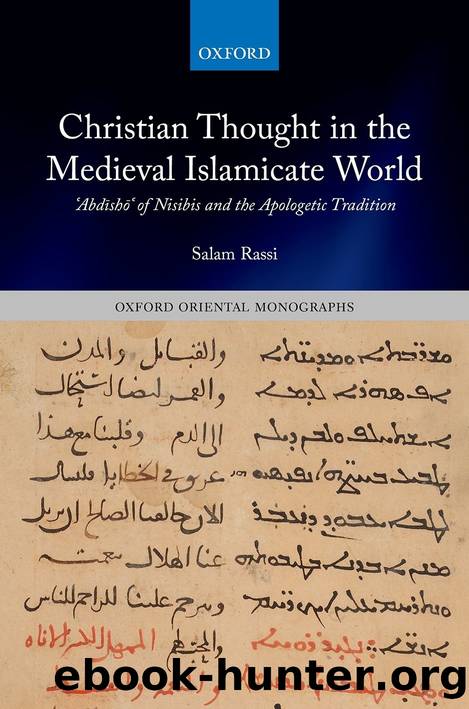Christian Thought in the Medieval Islamicate World by Salam Rassi;

Author:Salam Rassi; [Rassi, Salam]
Language: eng
Format: epub
ISBN: 9780192662170
Publisher: OUP Premium
Published: 2022-01-03T00:00:00+00:00
4.2.2 From Ê¿aá¹£abiyya to Ecumenism: Ê¿AbdÄ«shÅÊ¿âs Arabic Christology
Having examined the way Ê¿AbdÄ«shÅÊ¿ expresses Christological difference in his Syriac Pearl, we now turn our attention to his Arabic Christology. As we observed in the previous section, the Pearlâs discussion of Christology takes place within a church-historical framework in which narratives about Ephesus appear alongside discourses on Christâs natures. Now, although the ideas expressed in his Arabic works are in keeping with the same doctrinal traditions, the literary forms underlying them differ in some important regards.
The literary forms in question are rooted in ChristianâMuslim discussions about the Incarnation, a feature that is impossible to overlook where Ê¿AbdÄ«shÅÊ¿âs Arabic Christology is concerned. As we observed in Section 4.1, Muslim and Jewish theologians often took note of the historical divisions among Christians, enumerating and outlining these positions before refuting them all as equally objectionable. This strategy is paralleled in Christian Arabic theological writing from the early Abbasid period onwards. Typically, Christian writers outlined the three main positions before championing their own and refuting the remaining two. As Mark Beaumont has pointed out, this method was intended to inculcate key aspects of Christological doctrine to an internal audience while presenting âan apology designed to commend the doctrine of the Incarnation to a Muslim interlocutorâ.105 A central feature of this didacticism is the use of analogy and metaphor to explain the various modes of the union between the human and divine in Christ. To better understand Ê¿AbdÄ«shÅÊ¿âs use of this method, it is necessary to provide an overview of its earlier development.
The earliest iteration of this analogical approach comes from the writings of the Church Fathers, many of whom looked to Aristotelian and Stoic understandings of mixture, composition, and union, in order to adequately describe the coming together of Christâs natures.106 A systematic treatment of these analogies in Syriac occurs in Theodore bar KÅnÄ«âs Scholion, a late eighth-century summa in question-and-answer form, the tenth mÄmrÄ of which has received attention from Sydney Griffith concerning its anti-Muslim apologetic agenda.107 Of greater interest to us for the moment is Question 54 of the sixth mÄmrÄ. Here, Bar KÅnÄ« provides the following definition of union and its types, each of which he elucidates with a specific analogy:
Uniting is the bonding (ḥzÄqa) and confining (ʾassÄ«rūṯÄ) of separate things that are united as one thing and is the result of either two or more things. Its types are seven:
i. Natural (kyÄnÄyÄ) and qnÅmic (qnÅmÄyÄ), like the soul and the body that become one in nature and qnÅmÄ through uniting and the elements that unite and constitute the body of humans and animals;
ii. Voluntary union (ḥá¸ÄyÅ«á¹¯Ä á¹£eá¸yÄnÄytÄ), like a gathering of believers being one spirit and one mind (Acts 4:32);
iii. Conjunction (naqqÄ«pūṯÄ), like the man who will leave his father and mother to join his wife to become one in flesh (Gen 2:24, cf. Mat 19:6);
iv. Personal (pará¹£ÅpÄytÄ), like the messenger who assumes (lá¸eÅ¡) the person of the king;
v. Composition (rukkÄá¸Ä), like gold and silver that are composed (meṯraká¸Ä«n), and constitute a [single] chest (qÄʾá¸ÅṯÄ);
vi.
Download
This site does not store any files on its server. We only index and link to content provided by other sites. Please contact the content providers to delete copyright contents if any and email us, we'll remove relevant links or contents immediately.
Machine Learning at Scale with H2O by Gregory Keys | David Whiting(3660)
Never by Ken Follett(3549)
Fairy Tale by Stephen King(2971)
Will by Will Smith(2593)
Fantastic Beasts and Where to Find Them: The Original Screenplay by J. K. Rowling(2415)
The Storyteller by Dave Grohl(2073)
It Starts With Us (It Ends with Us #2) by Colleen Hoover(2058)
Friends, Lovers, and the Big Terrible Thing by Matthew Perry(2018)
Can't Hurt Me: Master Your Mind and Defy the Odds - Clean Edition by David Goggins(2012)
The Becoming by Nora Roberts(1932)
Cloud Cuckoo Land by Anthony Doerr(1925)
New Morning Mercies: A Daily Gospel Devotional by Paul David Tripp(1821)
HBR's 10 Must Reads 2022 by Harvard Business Review(1703)
The Complete Witcher by Andrzej Sapkowski(1700)
Cytonic by Brandon Sanderson(1687)
A Short History of War by Jeremy Black(1679)
Go Tell the Bees That I Am Gone by Diana Gabaldon(1602)
Leviathan Falls (The Expanse Book 9) by James S. A. Corey(1530)
515945210 by Unknown(1525)
